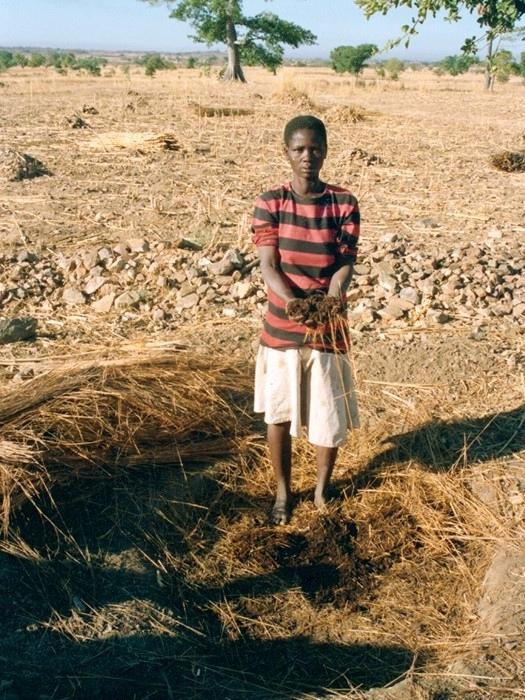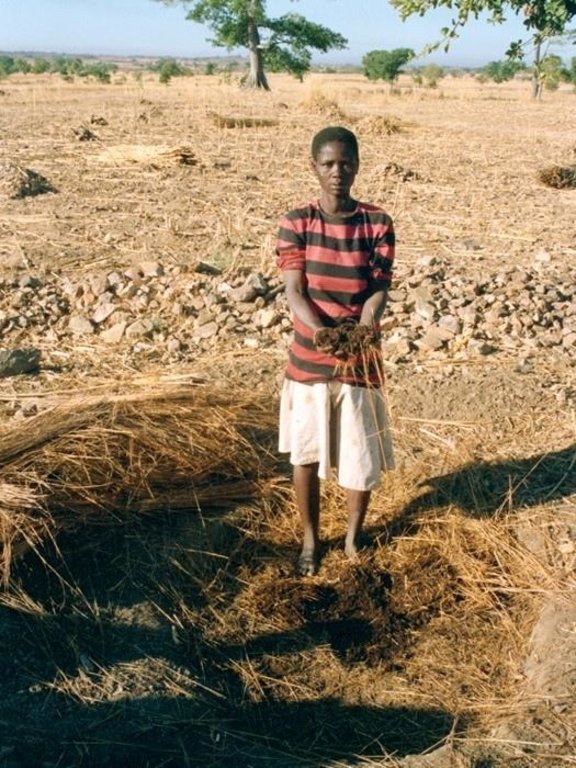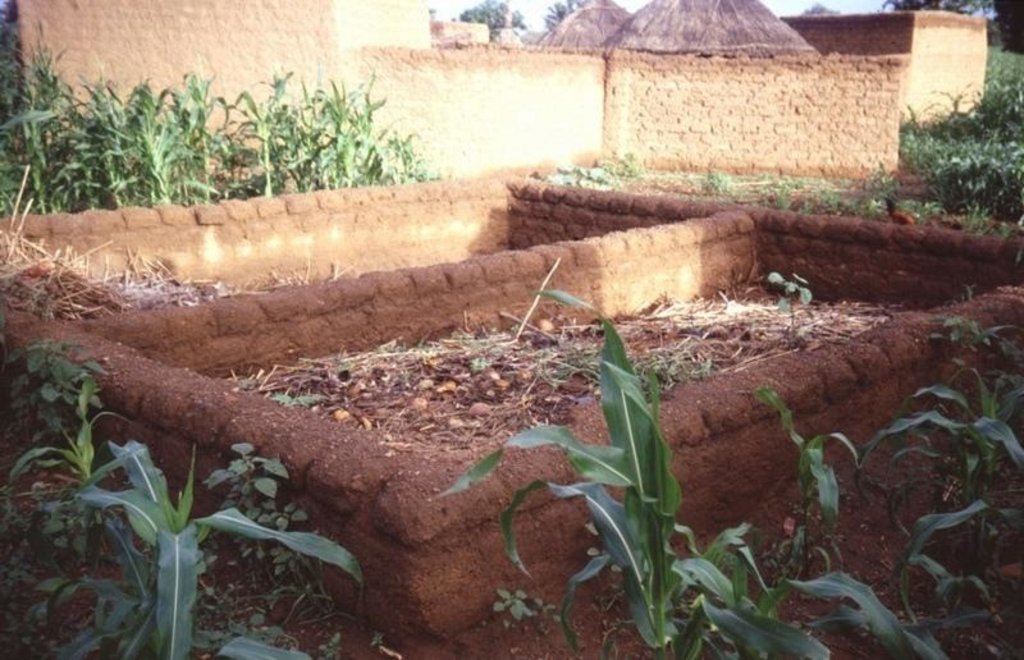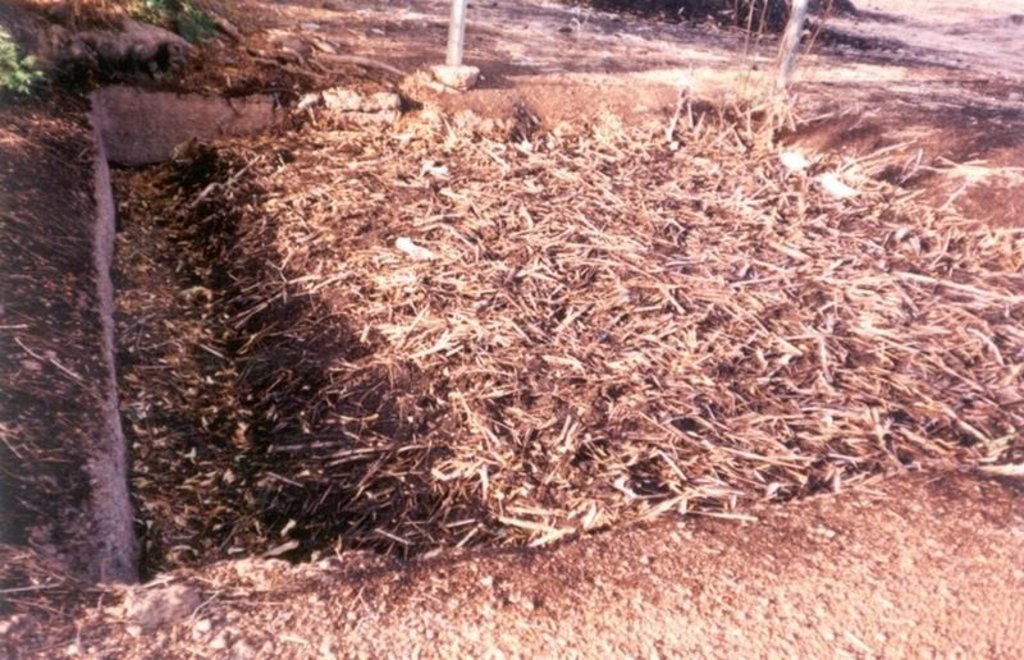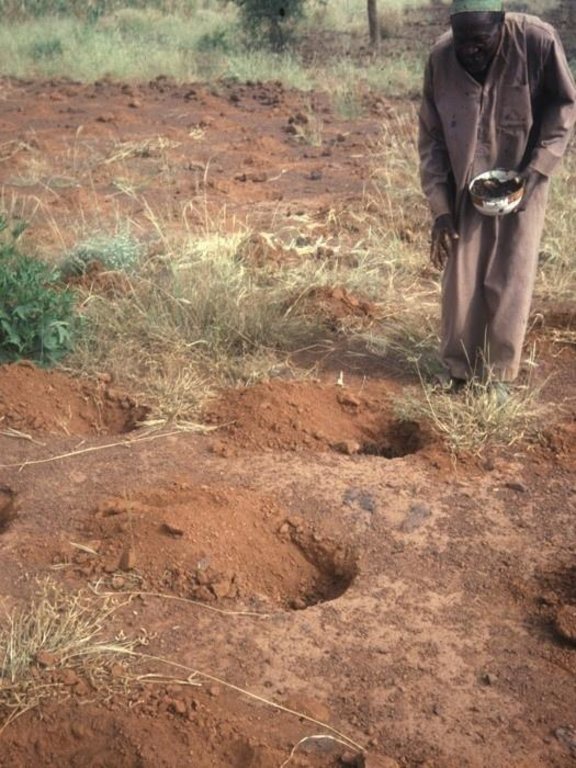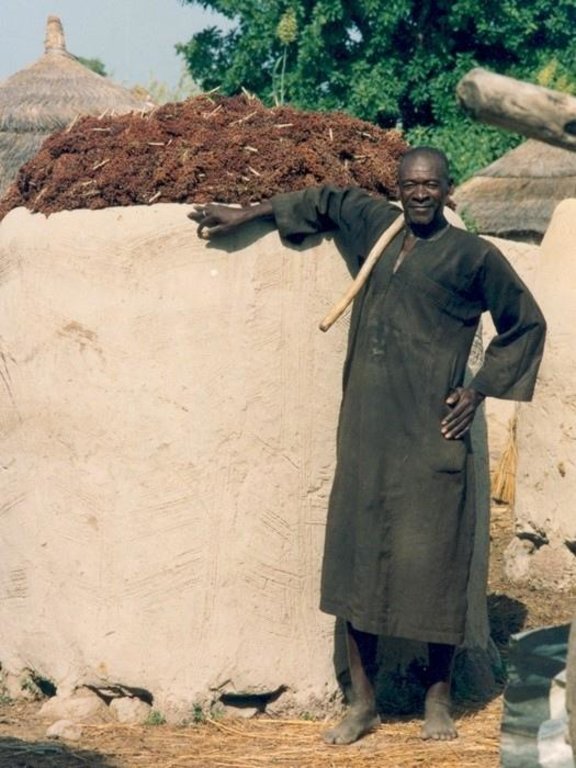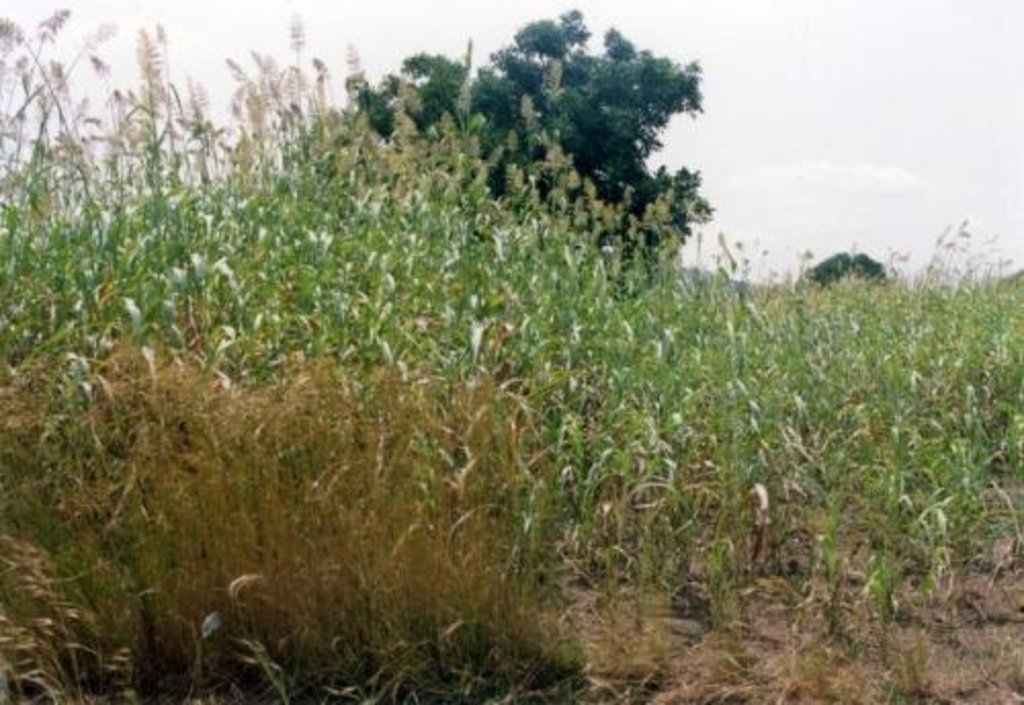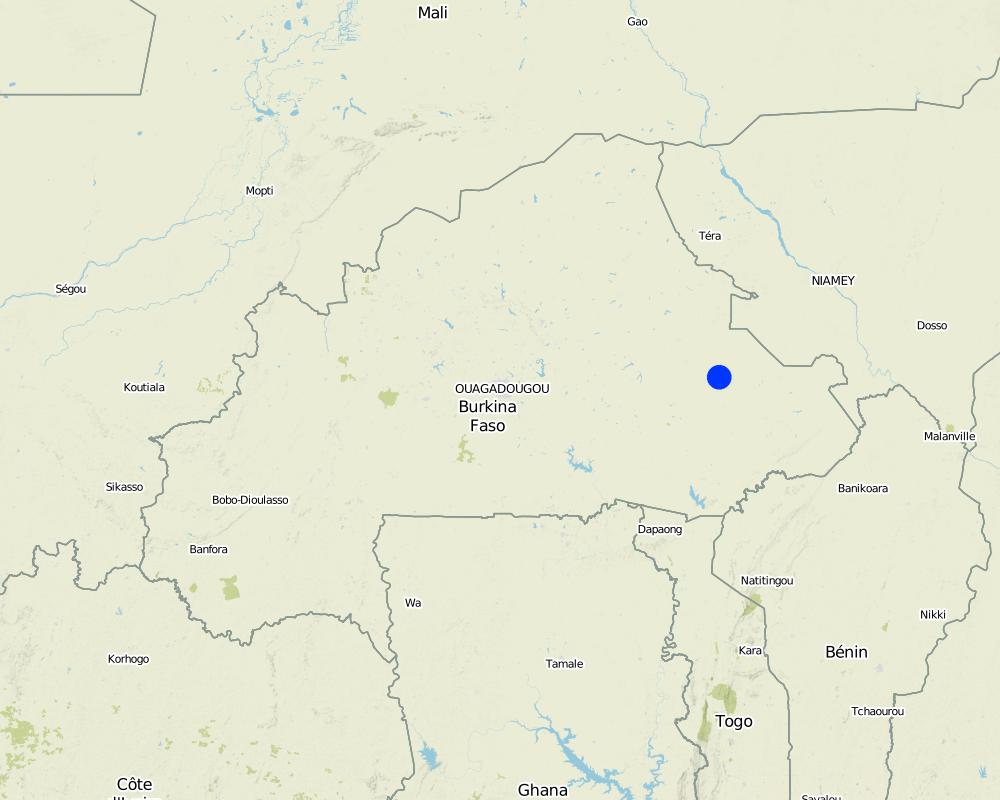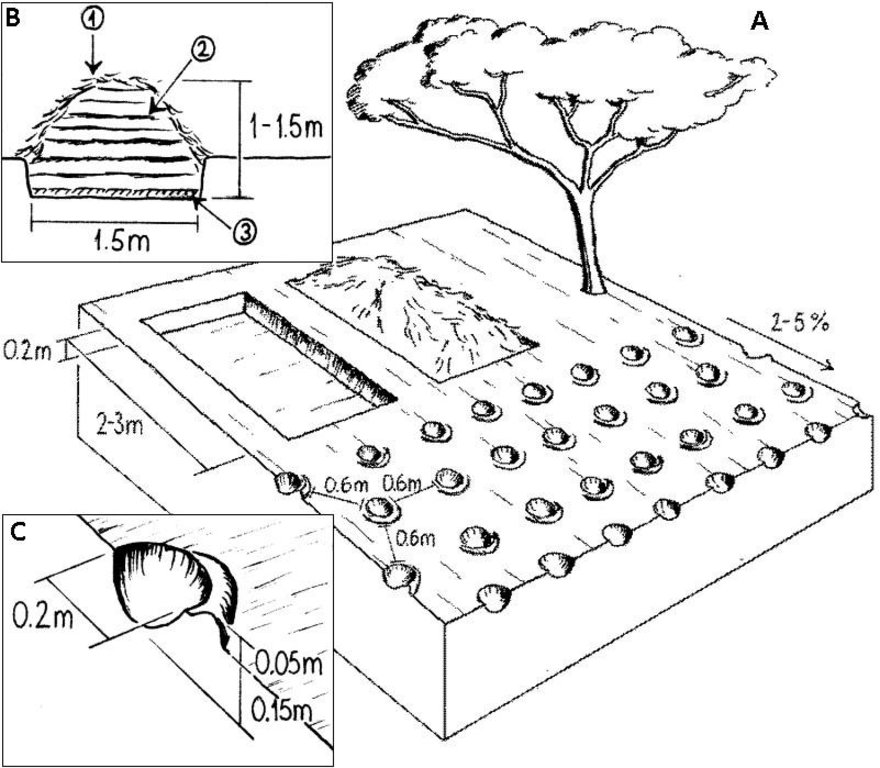Composting associated with planting pits [Буркина Фасо]
- Создание:
- Обновить:
- Составитель: Moussa Bonzi
- Редактор: –
- Рецензенты: Fabian Ottiger, Alexandra Gavilano
Zai avec apport de compost (french)
technologies_959 - Буркина Фасо
Просмотреть разделы
Развернуть все Свернуть все1. Общая информация
1.2 Контактные данные специалистов и организаций, участвующих в описании и оценке Технологии
Ответственный (-ые) специалист (-ы)
Специалист по УЗП:
De Pury Jean Pascal Etienne
Centre Ecologique Albert Schweitzer (CEAS)
Швейцария
Специалист по УЗП:
Ouedraogo Elisée
Centre Ecologique Albert Schweitzer (CEAS)
Швейцария
Специалист по УЗП:
Название проекта, содействовавшего документированию/оценке Технологии (если применимо)
Book project: where the land is greener - Case Studies and Analysis of Soil and Water Conservation Initiatives Worldwide (where the land is greener)Название проекта, содействовавшего документированию/оценке Технологии (если применимо)
Book project: SLM in Practice - Guidelines and Best Practices for Sub-Saharan Africa (SLM in Practice)Название организации (-ий), содействовавших документированию/оценке Технологии (если применимо)
Centre Ecologique Albert Schweitzer (CEAS) - ШвейцарияНазвание организации (-ий), содействовавших документированию/оценке Технологии (если применимо)
INERA Institut de l'environnement et de recherches agricoles (INERA Institut de l'environnement et de recherches agricoles) - Буркина Фасо1.3 Условия, регламентирующие использование данных, собранных ВОКАТ
Составитель и ответственный(-ые) специалист(-ы) согласны с условиями, регламентирующими использование собранных ВОКАТ данных:
Да
1.5 Ссылка на Анкету (ы) по Подходам УЗП (документируется с использованием ВОКАТ)
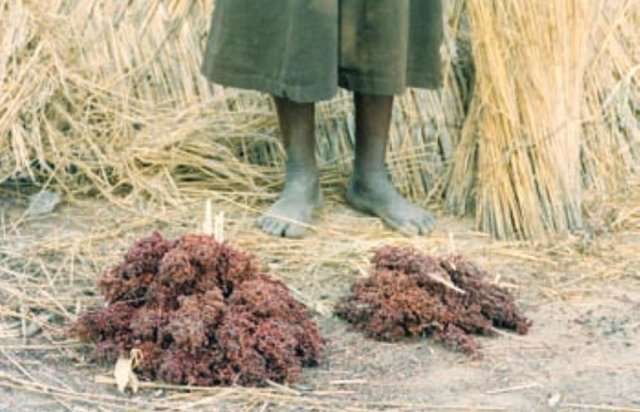
Zabré women’s agroecological programme [Буркина Фасо]
A demand-driven initiative, by a women’s association, aimed at the promotion of composting through training and extension, using project staff and local facilitators.
- Составитель: Unknown User
2. Описание Технологии УЗП
2.1 Краткое описание Технологии
Определение Технологии:
Compost production, and its application in planting pits (zai) by farmers on fields near their homes.
2.2 Подробное описание Технологии
Описание:
Compost is produced in shallow pits, approximately 20 cm deep and 1.5 m by 3 m wide. During November and December layers of chopped crop residues, animal dung and ash are heaped, as they become available, up to 1.5 m high and watered. The pile is covered with straw and left to heat up and decompose. After around 15-20 days the compost is turned over into a second pile and watered again. This is repeated up to three times - as long as water is available. Compost heaps are usually located close to the homestead. Alternatively, compost can be produced in pits which are up to one metre deep. Organic material is filled to ground level. The pit captures rain water, which makes this method of composting
a valuable option in dry areas.
The compost is either applied immediately to irrigated gardens, or kept in a dry shaded place for the next sorghum seeding. In the latter case one handful of compost is mixed with loose soil in each planting pit (zai). These pits are dug 60 cm by 60 cm apart. Three to four grains of sorghum are planted in each pit. Compost in the pits both conserves water and supplies nutrients. This enables the sorghum plants to establish better, grow faster and reach maturity before the rains finish. As compost is applied locally to the crop, not only is the positive effect maximised, but also the weeds between the pits do not benefit. The water retaining capacity of the compost (absorbing several times its own weight) makes the difference. This is much more important than the additional nutrients, which only become available in subsequent years, and do not anyway completely replace all the nutrients extracted by the crops.
The planting pits also help by harvesting runoff water from the microcatchments between them. Boulgou experiences erratic and variable rainfall with frequent droughts. The poor soils are often crusted and have a low water-retention capacity. Due to a high and increasing population, the land has become exhausted, and fallow periods are no longer sufficient as a consequence. Fertility and yields have declined. Sorghum without compost is more vulnerable to drought and crop failure.
During the dry season, after harvest, fields are grazed by cattle of the nomadic pastoral Peuhl, who also herd the agriculturalists’ livestock. Interestingly, the Peuhl have started to systematically collect the manure for sale, since the increased demand (for composting) has led to doubling of the price. Composting has been applied in Boulgou Province of Burkina Faso since 1988.
2.3 Фотографии, иллюстрирующие Технологию
2.5 Страна/ регион/ места, где применяется Технология, информация о которых собрана в данной Анкете
Страна:
Буркина Фасо
Административная единица (Район/Область):
Boulgou Province, Burkina Faso
Пояснения:
Total area covered by the SLM Technology is 200 km2.
Map
×2.7 Внедрение Технологии
Укажите, как именно Технология УЗП была внедрена:
- через проекты/ внешнее вмешательство
3. Классификация Технологии УЗП
3.1 Основные цели и задачи реализации Технологии
- повышение производства
- создание благоприятных экономических условий
3.2 Текущий(-ие) тип(-ы) землепользования на территории, где применяется Технология
Комбинированное землепользование в пределах одной и той же земельной единицы:
Да
Укажите сочетания типов землепользования (посевы / пастбища / деревья):
- Агро-лесо-пастбищное хозяйство

Пахотные угодья и плантации
- Однолетние культуры
Ежегодный урожай - Уточните культуры:
- масличные культуры - арахис
- зерновые культуры - кукуруза
- зерновые культуры - сорго
- овощи - листовые овощи (салаты, капуста, шпинат, другие)
- овощи - корнеплоды (морковь, лук, свекла, другие)
- бобовые - зеленый горошек
Поясните:
Longest growing period in days: 180 Longest growing period from month to month: May - Oct
Применяется ли севооборот?
Да

Пастбищные угодья
Вид животных:
- козы
- мулы и ослы
- zebu cattle

Леса/ лесистая местность
Продукции и услуги:
- Дрова
- Плоды и орехи
Пояснения:
Major land use problems (compiler’s opinion): Population increase has led to cultivation of all the available arable land, thus shortening or eliminating fallow periods.
Organic matter in the soil is reduced, the water holding capacity of the soil has diminished and consequently yields have fallen. This has been compounded by the droughts of the 1970s and 1980s. Thirty years ago farmers harvested 800 kg/ha each year, but by the 1980s yields had fallen to merely 400 kg/ha on average.
Main products/ services: Sorghum and zebu cattle (after harvest)
3.4 Водоснабжение
Обеспеченность водой участков, где реализуется Технология :
- богарные земли
3.5 Категория УЗП, к которой относится Технология
- Улучшение почвенного/ растительного покрова
- Комплексное управление почвенным плодородием
- сбор атмосферных осадков
3.6 Мероприятия УЗП, выполняемые в рамках Технологии

Агрономические мероприятия
3.7 Основные проблемы деградации земель, на решение которых направлена Технология

водная эрозия почв
- ВЭп: поверхностная эрозия/смыв верхних почвенных горизонтов

ухудшение химических свойств почв
- Хп: Снижение плодородия и уменьшение содержания органического вещества (вызванное не эрозией, а другими причинами)

ухудшение физических свойств почв
- Фу: уплотнение
- Фк: растрескивание и коркообразование

деградация водных ресурсов
- Ва: почвенная засуха
Пояснения:
Main type of degradation addressed: Wt: loss of topsoil / surface erosion, Cn: fertility decline and reduced organic matter content, Pc: compaction, Pk: sealing and crusting, Ha: aridification
Main causes of degradation: over-exploitation of vegetation for domestic use, other human induced causes (specify) (causes agricoles: Suppression des jachères; surpâturage), other natural causes (avalanches, volcanic eruptions, mud flows, highly susceptible natural resources, extreme topography, etc.) specify (Secheresse du sol due à la destruction de l'humus plus qu'aumanque de pluie.), Expansion démographique, manque de connaissances (Comment acquerir ces connaissances)
Secondary causes of degradation: deforestation / removal of natural vegetation (incl. forest fires), manque de moyens financiers (comment en produire avec des connaissances)
3.8 Предотвращение и снижение деградации земель, или восстановление нарушенных земель
Укажите цель Технологии по отношению к деградации земель :
- снижение деградации земель
4. Технические характеристики, мероприятия по практической реализации, вложения и стоимость
4.1 Технический рисунок, иллюстрирующий Технологию
Спецификация (пояснения к техническому рисунку):
A: Overview of compost making and zai planting pits within a field. Tree shade helps to conserve moisture in the compost pits.
B: Cross section of compost pit: protective straw (1); successive layers of compost (2), clay layer at the bottom (3).
C: Detailed view of zai planting pit.
Technical knowledge required for field staff / advisors: low
Technical knowledge required for land users: moderate
Main technical functions: increase / maintain water stored in soil
Secondary technical functions: increase in organic matter, increase of infiltration, increase in soil fertility, improvement of soil structure
Manure / compost / residues
Material/ species: compost
Quantity/ density: 7-10 t/ha
Remarks: applied in planting pits
Автор:
Mats Gurtner
4.3 Мероприятия, необходимые для начала реализации
| Деятельность | Время (сессия) | |
|---|---|---|
| 1. | Transport compost to the fields: | April / annual |
| 2. | Deepen planting pits (zai) (to original dimensions of 15 cm deep, 20 cm diameter, and 60 cm apart) and apply a handful of compost mixed with earth, just before planting sorghum | After the first rains / annual |
Пояснения:
Editors’ comments: Soil fertility decline is a major problem for much of Africa, and composting provides an opportunity for local mitigation of this. There are many ways of making compost, and this case is a good example of ‘aerobic heap compost’ from Burkina Faso. Here, the compost is concentrated in planting pits, which additionally harvest water.
4.4 Вложения и затраты, необходимые для начала реализации
| Опишите затраты | Единица | Количество | Затраты на единицу | Общая стоимость на единицу | % затрат, оплаченных землепользователями | |
|---|---|---|---|---|---|---|
| Оплата труда | Labour | ha | 1,0 | 2,0 | 2,0 | 100,0 |
| Оборудование | Tools | ha | 1,0 | 10,0 | 10,0 | 100,0 |
| Строительные материалы | Clay | 1 | ||||
| Общая стоимость запуска Технологии | 12,0 | |||||
| Общие затраты на создание Технологии в долларах США | 12,0 | |||||
4.5 Поддержание/ текущее обслуживание
| Деятельность | Сроки/ повторяемость проведения | |
|---|---|---|
| 1. | Dig two compost pits (3 m by 1.5 m and 20 cm deep). Cover the bottom of each pit with 3 cm clay layer. | beginning of the dry season (November). / initial establishment |
| 2. | Put 20 cm layer of chopped crop residues (cereal straw) into thecompost pit (water with one bucket). Add 5 cm layer of animal manure. Add 1 cm layer of ash. Repeat steps 1–3 until the compost pile is 1.0–1.5 m high. | November / annual |
| 3. | Cover pile with straw to reduce evaporation, and leave to decompose. | November / annual / up to 3 times (as long as water is available) |
| 4. | Turn compost after 15 days into the 2nd pit, then after another 15 days back into the 1st pit. Water the pile after each turning with 3 buckets of water. | / up to 3 times (as long as water is available) |
| 5. | Store ready compost in dry shady place. | January / annual |
4.6 Стоимость поддержания/ текущего обслуживания ( в год)
| Опишите затраты | Единица | Количество | Затраты на единицу | Общая стоимость на единицу | % затрат, оплаченных землепользователями | |
|---|---|---|---|---|---|---|
| Оплата труда | Labour | ha | 1,0 | 20,0 | 20,0 | 100,0 |
| Оборудование | Wheelbarrow renting | ha | 1,0 | 6,0 | 6,0 | 100,0 |
| Оборудование | None | None | 1,0 | |||
| Оборудование | None | None | 1,0 | |||
| Удобрения и ядохимикаты | Compost/manure | ha | 1,0 | 2,0 | 2,0 | 100,0 |
| Строительные материалы | Wet straw | ha | ||||
| Строительные материалы | ash | ha | ||||
| Другие | Compost transportation | ha | 1,0 | 2,0 | 2,0 | 100,0 |
| Общая стоимость поддержания Технологии | 30,0 | |||||
| Общие затраты на поддержание Технологии в долларах США | 30,0 | |||||
Пояснения:
Machinery/ tools: hoe, knife, digging stick, bucket
Costs relate to production and application of one ton of compost per hectare - which a farmer can make in one year and is the product of one full compost pit. The compost is directly applied to each planting pit: since the pits all in all
constitute only around 10-15% of the field surface, compost is effectively applied at a concentration of 7-10 t/ha. This rate is equal to actual rates applied in small irrigated gardens (<0.1 ha). If compost is produced in deep pits, production is cheaper because there is less work involved.
4.7 Наиболее значимые факторы, влияющие на стоимость затрат
Опишите наиболее значимые факторы, влияющие на стоимость затрат:
Duration of establishment: 1 week
5. Природные и социально-экономические условия
5.1 Климат
Среднегодовое количество осадков
- < 250 мм
- 251-500 мм
- 501-750 мм
- 751-1000 мм
- 1001-1500 мм
- 1501-2000 мм
- 2001-3000 мм
- 3001-4000 мм
- > 4000 мм
Агроклиматическая зона
- полузасушливая
Thermal climate class: tropics
5.2 Рельеф
Склоны (преобладающие):
- пологие (0-2%)
- покатые (3-5%)
- покато-крутые (6-10%)
- крутые (11-15%)
- очень крутые (16-30%)
- чрезвычайно крутые (31-60%)
- обрывистые (>60%)
Формы рельефа:
- плато/ равнины
- гребни хребтов/холмов
- склоны гор
- склоны холмов
- подножья
- днища долин
Зона высотной поясности:
- 0-100 м над уровнем моря
- 101-500 м н.у.м.
- 501-1000 м н.у.м.
- 1001-1500 м н.у.м.
- 1501-2000 м н.у.м.
- 2001-2500 м н.у.м.
- 2501-3000 м н.у.м.
- 3001-4000 м н.у.м.
- > 4 тыс. м н.у.м.
5.3 Почвы
Средняя мощность почв:
- поверхностные (0-20 см)
- неглубокие (21-50 см)
- умеренно глубокие (51-80 см)
- глубокие (81-120 см)
- очень глубокие (> 120 см)
Гранулометрический состав (верхнего горизонта):
- грубый крупнозернистый/ лёгкий (песчаный)
- тонкодисперсный/ тяжёлый (глинистый)
Содержание органического вещества в верхнем горизонте:
- низкое (< 1%)
Если возможно, приложите полное описание почв или укажите доступную информацию, например тип почв, рH/ кислотность почв, ёмкость катионного обмена, содержание азота, содержание солей и т.д.
Soil texture: Fine / heavy (elevations) and coarse/light (depressions)
Soil fertility: Low (ranked 1) and medium (ranked 2)
Topsoil organic matter: Low (and decreasing further)
Soil drainage/infiltration: Poor (ranked 1) and medium (ranked 2)
Soil water storage capacity: Low
5.6 Характеристика землепользователей, применяющих Технологию
Рыночная ориентация производства:
- натуральное хозяйство (самообеспечение)
- смешанный (натуральный / коммерческий)
Доходы из других источников:
- < 10% всех доходов
Уровень механизации:
- ручной труд
- тягловая сила
Укажите другие важные характеристики землепользователей:
Market orientation: Subsistence (ranked 1) and mixed (ranked 2, in good years)
5.7 Средняя площадь земель, используемых землепользователями с применением Технологии
- < 0,5 га
- 0,5-1 га
- 1-2 га
- 2-5 га
- 5-15 га
- 15-50 га
- 50-100 га
- 100-500 га
- 500-1000 га
- 1000-10000 га
- > 10000 га
Пояснения:
Average area of land owned or leased by land users applying the Technology: 0.5-1 ha, 1-2 ha, 2-5 ha
5.8 Собственность на землю, права на земле- и водопользование
Землевладелец:
- общинная/ поселковая
Право землепользования:
- общинное (контролируемое)
6. Воздействия и заключительные положения
6.1 Влияние Технологии УЗП в пределах территории ее применения
Социально-экономическое воздействие
Продуктивность
производство сельскозяйственных культур
производство кормов
качество кормов
Доходы и затраты
доходы хозяйства
Комментарий/ пояснения:
By several times in dry years, compared to no compost use
объем работ
Другое социально-экономическое воздействие
Integration of agriculturalists and pastoralists
Input constraints
Комментарий/ пояснения:
Water for compost making
Социальное и культурное воздействие
местное самоуправление
смягчение конфликтов
Экологическое воздействие
Водный цикл/ поверхностный сток
водный дренаж
Почвы
влажность почв
почвенный покров
утрата почв
Другие экологические последствия
Soil fertility
6.4 Анализ эффективности затрат
Насколько получаемый результат сопоставим с первоначальными вложениями (с точки зрения землепользователей)?
Эффективность затрат в краткосрочной перспективе:
очень позитивное
Эффективность затрат в долгосрочной перспективе:
очень позитивное
Насколько получаемый результат сопоставим с текущими расходами по поддержанию технологии (с точки зрения землепользователей)?
Эффективность затрат в краткосрочной перспективе:
очень позитивное
Эффективность затрат в долгосрочной перспективе:
очень позитивное
6.5 Внедрение Технологии
Если возможно, дайте количественную характеристику (число домохозяйств и/или площадь применения):
5000
Среди применяющих Технологию землепользователей, какова доля лиц, применяющих её по собственной инициативе, т.е. без какого-либо материального стимулирования со стороны?
- 91-100%
Пояснения:
100% of land user families have adopted the Technology without any external material support
There is a strong trend towards spontaneous adoption of the Technology
Comments on adoption trend: Strong trend towards growing spontaneous adoption. Almost everybody wants to imitate neighbors - but not everyone had received adequate training. Demand grew because of the expanded membership of the association. Some pastoralists use it in their gardens.
6.7 Сильные стороны/ преимущества/ возможности Технологии
| Сильные стороны/ преимущества/ возможности по мнению составителя или других ключевых специалистов |
|---|
|
All land users, even the poorest, can learn to make and apply compost. No jealousy amongst land users, which is a prerequisite for ist spread/acceptance How can they be sustained / enhanced? Keep going with training and extension. |
|
Possibility of doubling cereal yields in normal years: any surplus production can be sold How can they be sustained / enhanced? Produce enough good compost/manure. |
| Ensures yields in dry years, giving security against drought and hunger. |
|
Gives high income in dry years due to production increase and double prices on the market for the surplus How can they be sustained / enhanced? However the government is attempting to stabilise prices, so this benefit might not endure. |
| Requires only locally available resources, and knowledge about compost application is ‘owned’ by the farmers: nobody can take it away from them. |
6.8 Слабые стороны/ недостатки/ риски Технологии и пути их преодоления
| Слабые стороны/ недостатки/ риски по мнению составителя или ответственных специалистов | Возможные пути их преодоления/снижения? |
|---|---|
| The modest quantity of compost applied is not enough to replace the nutrients extracted by the crops in the long term | Small amounts of nitrogen and phosphorous fertiliser need to be added and crop rotation practiced. |
| The short/medium term local benefits are not associated with a positive overall, long-term ecological impact because there is a net transfer of organic matter (manure) to the fields from the surroundings | Improve management of the vegetation outside the cropland, avoiding overgrazing etc to increase manure production. |
| Needs considerable water and thus also extra labour | Pit composting helps to reduce water requirement in drier areas and at the same time reduces labour input. |
7. Справочные материалы и ссылки
7.1 Методы сбора/ источники информации
7.2 Ссылки на опубликованные материалы
Название, автор, год публикации, ISBN:
Ouedraogo E . Influence d’un amendement de compost sur sol ferrugineux tropicaux en milieu paysan. Impact sur laproduction de sorgho à Zabré en 1992. Mémoire de diplôme.. 1992.
Где опубликовано? Стоимость?
CEAS Neuchâtel, Switzerland
Название, автор, год публикации, ISBN:
Zougmore R, Bonzi M, et Zida Z . Etalonnagedes unités locales de mesures pour le compostage en fosse de type unique étanche durable. Fiche technique de quantification des matériaux decompostage, 4pp. 2000.
Название, автор, год публикации, ISBN:
Zougmore R, Bonzi M, et Zida Z . Etalonnagedes unités locales de mesures pour le compostage en fosse de type unique étanche durable. Fiche technique de quantification des matériaux decompostage, 4pp. 2000.
Название, автор, год публикации, ISBN:
Zougmore R, Bonzi M, et Zida Z . Etalonnagedes unités locales de mesures pour le compostage en fosse de type unique étanche durable. Fiche technique de quantification des matériaux decompostage, 4pp. 2000.
Название, автор, год публикации, ISBN:
Zougmore R, Bonzi M, et Zida Z . Etalonnagedes unités locales de mesures pour le compostage en fosse de type unique étanche durable. Fiche technique de quantification des matériaux decompostage, 4pp. 2000.
Название, автор, год публикации, ISBN:
Zougmore R, Bonzi M, et Zida Z . Etalonnagedes unités locales de mesures pour le compostage en fosse de type unique étanche durable. Fiche technique de quantification des matériaux decompostage, 4pp. 2000.
Ссылки и модули
Развернуть все Свернуть всеСсылки

Zabré women’s agroecological programme [Буркина Фасо]
A demand-driven initiative, by a women’s association, aimed at the promotion of composting through training and extension, using project staff and local facilitators.
- Составитель: Unknown User
Модули
Нет модулей


